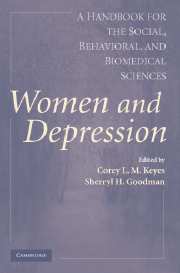Book contents
- Frontmatter
- Contents
- List of Contributors
- Foreword
- Preface
- PART I NOSOLOGY, MEASUREMENT, AND THE EPIDEMIOLOGY OF WOMEN AND DEPRESSION
- PART II BIOLOGICAL, DEVELOPMENTAL, AND AGING MODELS OF RISK
- PART III COGNITIVE, EMOTIONAL, AND INTERPERSONAL MODELS OF RISK
- PART IV SOCIAL, POLITICAL, AND ECONOMIC MODELS OF RISK
- 12 Social Suffering, Gender, and Women's Depression
- 13 Women, Work, and Depression
- 14 Culture, Race/Ethnicity, and Depression
- 15 Trauma and Depression
- 16 Public Health Approach to Depression and Women
- PART V SYSTEMS AND PROCESSES OF TREATMENT, PREVENTION, AND POLICY
- Author Index
- Subject Index
- References
15 - Trauma and Depression
Published online by Cambridge University Press: 05 June 2012
- Frontmatter
- Contents
- List of Contributors
- Foreword
- Preface
- PART I NOSOLOGY, MEASUREMENT, AND THE EPIDEMIOLOGY OF WOMEN AND DEPRESSION
- PART II BIOLOGICAL, DEVELOPMENTAL, AND AGING MODELS OF RISK
- PART III COGNITIVE, EMOTIONAL, AND INTERPERSONAL MODELS OF RISK
- PART IV SOCIAL, POLITICAL, AND ECONOMIC MODELS OF RISK
- 12 Social Suffering, Gender, and Women's Depression
- 13 Women, Work, and Depression
- 14 Culture, Race/Ethnicity, and Depression
- 15 Trauma and Depression
- 16 Public Health Approach to Depression and Women
- PART V SYSTEMS AND PROCESSES OF TREATMENT, PREVENTION, AND POLICY
- Author Index
- Subject Index
- References
Summary
Considerable evidence exists to suggest that traumatic events contribute toward vulnerability for major depression throughout the lifespan (Brown & Harris, 1993; Finlay-Jones & Brown, 1981; Kendler, Karkowski, & Prescott, 1999). However, the timing of the trauma may constitute an especially important variable in the development of long-term vulnerabilities toward depression and other psychiatric disorders including posttraumatic stress disorder (PTSD). Traumatic events occurring early in life appear to result in persistent alterations in neurobiological stress systems, increasing one's vulnerability to develop major depression. These early-life stress-induced changes include neuroendocrine, neurochemical, and neuroanatomical alterations. Increasing data derived from clinical and preclinical studies lend support to the view that these neurobiological changes associated with trauma experienced early in life occur after undue stress during particular critical developmental periods. These studies also support the important contribution of early-life traumas in the development of symptoms of depression and anxiety. In addition, this neurobiological vulnerability secondary to early-life trauma may permanently increase susceptibility to depression by rendering individuals more sensitive to stress throughout their adult life. Women are particularly vulnerable to depression; approximately twice as many women (12%) as men (7%) endure a depressive episode each year (Nolen-Hoeksema,; 1987). Lifetime risk of depression is also higher for women; 21% of women and 13% of men in the United States will experience an episode of major depression in their lifetime (Kessler et al., 1994). Higher exposure of women to early life trauma might contribute to this gender-related risk (Weiss, Longhurst, & Mazure, 1999).
- Type
- Chapter
- Information
- Women and DepressionA Handbook for the Social, Behavioral, and Biomedical Sciences, pp. 360 - 381Publisher: Cambridge University PressPrint publication year: 2006
References
- 3
- Cited by



